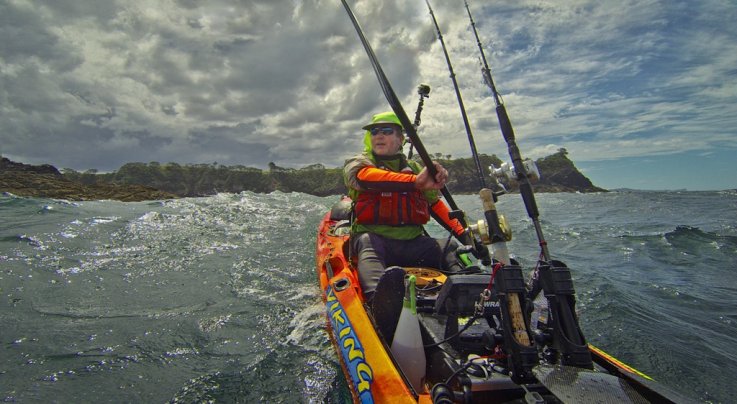Why trolling bibbed lures can be so successful
5:26PM 28th Feb 14

One lure out, one lure in, and beginning a fast down-wind run to try for another king. Trolling bibbed lures from kayaks is gaining popularity as a way of targeting a wide variety of fish including tuna, kingfish, and even snapper
Flashing silver and shuddering kayaks
It’s just like the anticipation of circling gannets: excitement is building, the first test dives are producing, and the frenzy is about to begin! There’s a growing swell of whispers and stories about kayakers having great success trolling hard body and bibbed lures, and the repeated reports describing the variety of species landed are finally beginning to register. Far from being considered fluky accidents, captures of specie like snapper are now no longer scoffed at. This gain in credibility as a technique viable for kayak anglers is generating a marked rise in interest.
The greatest appeal with trolling lures is allowing anglers to continue fishing even while paddling, and this is something we tend to devote a large portion of each trip to! We may be moving between fishing spots, prospecting for new fishing grounds, or using a sounder to find exactly where fish are lurking. In fact trolling bibbed lures capable of taking snapper while I hunt around with my sounder has been a competition favorite of mine, and has resulted in more than one trip to the podium. I throw a diving lure out the back as I circle about, and it’s amazing how often this has caught a big fish or added different specie to the bag.
Just like the circling gannets mentioned above, all this quiet discussion, forum traffic, and behind the scenes activity isn’t going unnoticed, and I’m now fielding multiple enquiries every week asking for tips and techniques. Since many kayak anglers are asking similar questions I’m going to take this opportunity to outline the most commonly asked for pieces of information.
One lure is never enough; different shapes and styles give different actions and diving depths. Just like changing soft baits and jig heads changing hard body lures allows us to work different waters
Why troll bibbed lures and not another style?
It can be very successful trolling with a wide variety of lure types, and many anglers regularly catch a variety of specie on everything from softbaits to salt water flies. Other than being hit by kahawai the most common occurrence is hooking snapper on softbaits left trailing out the back of the kayak, especially if the angler regularly stops to allow the lure to sink before paddling off again. Bibbed lures add another whole dimension though, and when trolling I’ve found their performance far more consistent and reliable session after session.
The major difference with this lure type is having control over the depth you’re fishing and the lure’s action by selecting a design appropriate for what you want to achieve. Much like selecting different jig head shapes and weights, or changing tail styles when softbaiting, changing bibbed lures allows you to reach the strike zone with control over the look and sound of your offering. This makes it possible to target almost everything from snapper near the bottom in more than 20 meters of water to skippies and albacore smashing tiny bait fish just below the surface film.
Another factor making a big difference is the amount of sound and vibration sent out by bibbed lures. This allows predatory fish to hear them coming long before they appear, and to get set for an ambush. A classic example of this is to pass over a mid-water school of snapper and have the sounder show them as a set of rising streaks as they’re already homing in on the lure. On other occasions when hunting snapper it’s not unusual to see sign more than 10 – 15 meters below the depth you know your lure is swimming at and still end up with a strike! In fact this is one area where kayakers definitely have it over the boaties – we’re so much quieter we don’t disturb the fish, and I’ve had supposedly wary snapper come almost to the surface to snaffle my offerings.
Many of the lures ideally suited to trolling from kayaks have been designed for fresh water use and will need their hooks upgraded. Try and match hook size while upping the gauge (strength).
How do I stop fouling expensive lures on the bottom?
The answer to this is getting to know how each of your lures performs, in particular the depth it will swim to at your paddling speed. When I have new lures on board I dedicate a little time and troll them over a slowly shelving sandy bottom. By closely watching the sounder and my rod tip as the water gets shallower I can tell the depth they first start hitting the sand. I then add around a meter and consider this depth the absolute shallowest I’ll run that particular lure. To make this number easy to remember I lightly scratch it into the lures bib.
Another way to minimise losses is to select floating lures when fishing over foul ground. If you paddle onto an unexpected piece of structure or the bottom suddenly shelves, simply stop the kayak. As soon as the lure stops it will begin to float away from the bottom and you can choose to turn the kayak before paddling off again, or to wind the lure in until you’re back in deeper water.
As an interesting aside, I’ve had a lot of big fish strikes in this situation. It seems as though the lure attracts attention as it floats up and fish will shadow it. The instant you paddle off again or start winding to recover the lure it gets pounced on. Remember, strikes can happen at any time, including right at the side of the kayak!
Don’t rule out sinking bibbed lures through fear of losing them. I’ve found them very useful for targeting snapper and kings on bait balls in deeper water, and they’re my favourite when chasing gannet workups. All I do here is make sure if I’m running the lure 30 paddle strokes behind the kayak the water is at least 30m deep (or 40 meters for 40 paddle strokes, etc., etc.). This means regardless of my paddling speed, even when bucking heavy head winds on the up-wind circuit, there’s no chance of the lure reaching the bottom.
Is there one lure that will catch everything?
Unfortunately I have yet to find the Holy Grail of diving lures, the one that will catch all fish in all situations. With a little care in finding out what depth each lure runs at (see above) and by constantly checking the condition of knots, lines, and leaders, losses are minimal. This allows you to slowly build a collection over time. As with fishing softbaits and other lures, this will then allow you to change lures to target different specie in a variety of conditions.
As a starting point for kayak anglers, I’ve found the most versatile lures are floating divers up to 125mm long designed to dive to depths of 3 – 5 meters with a speed rating starting at around 2.5 knots. These will generally work at most paddlers comfortable trolling speeds, and will catch a range of species. Concentrate on lures designed for the fresh water market as these are most often designed for our slower trolling speeds. Commonly available salt water lures will often only start swimming properly at the fastest speeds we can paddle at.
Use an open loop, tie to a split ring, or use a clip to allow the lure to swim freely and make the most of its action
Should I use braid or mono?
For a variety of reasons my preference is definitely for braid. The primary reason is the finer line diameter creates less water resistance with two real benefits. The first is that this will allow lures to dive as deep as possible and maximise their performance. The second is less drag meaning less paddling effort. Though the drag of a fishing line passing through the water may seem insignificant, the accumulated work load over a day on the water can be huge, especially if fishing in a multi-day event.
The secondary benefit of running braid is the lack of stretch. This makes it much easier to monitor the performance of you lure by keeping an eye on the vibrations of the rod tip. Any softening or reduction is cause to stop and retrieve the lure to check for a piece of jellyfish or kelp. There’s nothing more disillusioning than winding in at the end of a torrid trolling session and finding something stuck on a hook – all that wasted paddling!
Match lures to rods and reels so they don’t overpower them, and use braid line for less water resistance and greater sensitivity to the lures action when it’s swimming behind the kayak.
Should I troll with rods in front or behind?
This is an area with plenty of debate, so here’s my opinion based on countless hours trying both scenarios. My preference is definitely to place any rod trolling a lure in front of me. In the first instance this allows me to monitor the performance of the lures in the water as conditions and paddling speeds change. Many of the lures I run have a “sweet spot”, a speed where they swim at their best, and this can be seen in the vibrations of the rod tip. This allows me to up my paddle stroke if a head wind is slowing me down, or reduce it when swells or a chop is push me along.
Of course, as in the discussion about line types, being able to see how a lure is swimming allows me to monitor moment by moment if a hook has fouled a piece of kelp, or if a half-hearted strike that didn’t rattle the ratchet has affected the action of the lure.
Another significant reason I like my rods in front of me is what happens after the strike. If running more than one lure this makes it considerably easier to clear the other line, especially when using a rudder to control the way your kayak turns toward the pressure from the running fish. Being able to clearly see both lines makes it possible to use the tip of the second rod to clear cross overs before they become tangles - hopefully!
Finally, a loaded rod tends to wedge into a rod holder, and even lightweight outfits can sometimes be a problem to remove. Heavier rigs with a large snapper or kingfish attached can be downright diabolical! Rather than turning in your seat and trying to extract a jerking and dancing rod, it’s much easier to reach forwards with both hands and far more control over you balance and pitch.
Written By Stephen Tapp for the NZ Fishing News magazine, read more of Stephens Fishing News articles HERE
Watch this example of the success you can get trolling hard body bibbed lures for snapper





